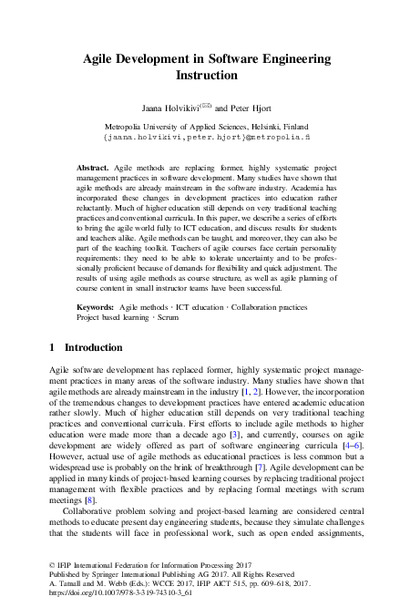Agile Development in Software Engineering Instruction Case Study for Grade 6 Students Group
Jaana Holvikivi, Peter Hjort
Zu finden in: Tomorrow's Learning: Involving Everyone. Learning with and about Technologies and Computing (Seite 609 bis 618), 2017
  |
 |
 Diese Seite wurde seit 4 Jahren inhaltlich nicht mehr aktualisiert.
Unter Umständen ist sie nicht mehr aktuell.
Diese Seite wurde seit 4 Jahren inhaltlich nicht mehr aktualisiert.
Unter Umständen ist sie nicht mehr aktuell.
 Zusammenfassungen
Zusammenfassungen
 Agile methods are replacing former, highly systematic project management practices in software development. Many studies have shown that agile methods are already mainstream in the software industry. Academia has incorporated these changes in development practices into education rather reluctantly. Much of higher education still depends on very traditional teaching practices and conventional curricula. In this paper, we describe a series of efforts to bring the agile world fully to ICT education, and discuss results for students and teachers alike. Agile methods can be taught, and moreover, they can also be part of the teaching toolkit. Teachers of agile courses face certain personality requirements: they need to be able to tolerate uncertainty and to be professionally proficient because of demands for flexibility and quick adjustment. The results of using agile methods as course structure, as well as agile planning of course content in small instructor teams have been successful.
Agile methods are replacing former, highly systematic project management practices in software development. Many studies have shown that agile methods are already mainstream in the software industry. Academia has incorporated these changes in development practices into education rather reluctantly. Much of higher education still depends on very traditional teaching practices and conventional curricula. In this paper, we describe a series of efforts to bring the agile world fully to ICT education, and discuss results for students and teachers alike. Agile methods can be taught, and moreover, they can also be part of the teaching toolkit. Teachers of agile courses face certain personality requirements: they need to be able to tolerate uncertainty and to be professionally proficient because of demands for flexibility and quick adjustment. The results of using agile methods as course structure, as well as agile planning of course content in small instructor teams have been successful. Dieses Kapitel erwähnt ...
Dieses Kapitel erwähnt ...
 Anderswo finden
Anderswo finden
 Volltext dieses Dokuments
Volltext dieses Dokuments
 |  Agile Development in Software Engineering Instruction: Artikel als Volltext bei Springerlink ( Agile Development in Software Engineering Instruction: Artikel als Volltext bei Springerlink ( : :  , 294 kByte; , 294 kByte;  : :  ) ) |
 Anderswo suchen
Anderswo suchen 
 Beat und dieses Kapitel
Beat und dieses Kapitel
Beat hat Dieses Kapitel während seiner Zeit am Institut für Medien und Schule (IMS) ins Biblionetz aufgenommen. Er hat Dieses Kapitel einmalig erfasst und bisher nicht mehr bearbeitet. Beat besitzt kein physisches, aber ein digitales Exemplar. Eine digitale Version ist auf dem Internet verfügbar (s.o.). Aufgrund der wenigen Einträge im Biblionetz scheint er es nicht wirklich gelesen zu haben. Es gibt bisher auch nur wenige Objekte im Biblionetz, die dieses Werk zitieren.











 Biblionetz-History
Biblionetz-History